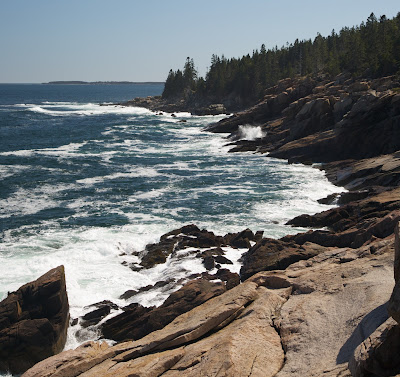Seaweed

The amount of seaweed covering the rocks was unlike anything I've seen anywhere else. You can get a sense of it in the panorama from Sand Beach and in this photo Tracy shot of the waves crashing against the rocks.

I liked the true-green piece hanging off of the yellowish weed in this detail. And the bokeh.
Barnacles and Mussels

In addition to being covered with seaweed, many of the rocks below the high-tide line are encrusted with barnacles and host to beds of mussels. I've never really had the opportunity to look at barnacles so closely — they're more interesting than I thought.

I didn't realize that they built such long tubes around themselves. And the purplish dots all over the rock also appear to be barnacles — I assume they're really young ones. Notice how they're growing on the bigger ones and, in the first picture, on the mussels. They seem to pretty much be able to out-compete everything else on the rocks for space, once they take hold.

A final picture: lots of bokeh and a drop of seawater on the top of a lone mussel in a bed of barnacles.
Tidal Pools

The rocks on Acadia's shore trap a lot of water as the tide rolls out, forming tidal pools.

I've seen tidal pools at Litchfield (where we usually go to the ocean), but they're nothing like these. The Litchfield tidal pools rarely trap any animals and certainly don't have a "permanent" population of flora.

The tidal pools at Acadia, on the other hand, appear to have permanent populations of both flora and fauna. As you can see, there are several different types of seaweed that live on the rocks and in the pools, along with periwinkle, barnacles, mussels, tiny crabs and shrimp, and (though I didn't find any) starfish.

I really regretted that I didn't have a lense/filter/kit that would let me break the water. Something for additional illumination would have been nice, too, so I could have more depth of field. What we ended up doing was holding my raincoat over top of whoever was taking the picture so that the glare on the surface of the water from the sky was largely blocked. It helped, but wasn't perfect.
Gulls

There were a couple of seagulls that seemed quite interested in having their picture taken. We don't usually find gulls very interesting, but then again, we don't usually see gulls that are quite so photogenic.

This is a particularly nice moment in the gull's landing; unfortunately, the Rebel just missed focus for this one.

At this point, we figured the gull got irritated that Tracy wasn't taking its picture: every time she put down the camera, it started yelling at her. When she picked it back up, it would stop. She finally did get this shot.
Miscellaneous

Tracy shot these flowers, which were really pretty, for some reason. Probably because there was so little color, since Acadia is at least a month behind Virginia in terms of the arrival of spring.

I shot this mass of lichen. I regret not paying more attention to what's growing out of it.

Tracy shot this plant that is trying to grow in a cleft of rock. I really like the composition.

Something about this shot that Tracy took really caught my fancy. Seems like a good parting photo for this set from Acadia.


































